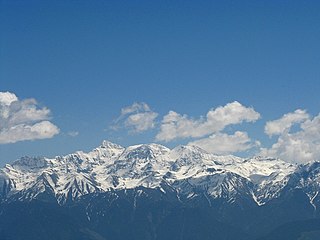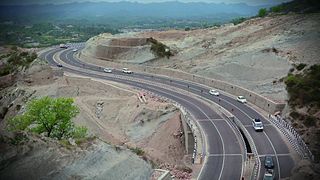
Udhampur (ˌʊd̪ʱəmpur) is a city and a municipal council in Udhampur district in the Indian union territory of Jammu and Kashmir. It is the headquarters of Udhampur District. Named after Raja Udham Singh, it serves as the district capital and the Northern Command headquarters of the Indian Army. A Forward Base Support Unit (FBSU) of the Indian Air Force is also stationed here. Udhampur is used by the Armed Forces as a transit point between Jammu and Srinagar when travelling by road on National Highway 1A, which has since been renamed as National Highway 44.

The Pir Panjal Range is a range of mountains in the Lower Himalayan region located in the Western Himalayas of northern Indian subcontinent. It runs southeast to northwest between the Beas and Neelam/Kishanganga rivers, in the Indian state of Himachal Pradesh and Indian-administered union territory of Jammu and Kashmir, with its northwestern end extending into territory administered by Pakistan. The Himalayas show a gradual elevation towards the Dhauladhar and Pir Panjal ranges. Pir Panjal is the largest and westernmost range of the Lesser Himalayas. Near the bank of the Sutlej River, it dissociates itself from the main Himalayan range and forms a divide between the Beas and Ravi rivers on one side and the Chenab on the other. Further west, the Pir Panjal range forms the southwestern boundary of the Kashmir Valley, separating it from the hills of Jammu region, forming a divide between the Jhelum and Chenab rivers.

Udhampur is an administrative district in the Jammu division of Indian-administered Jammu and Kashmir in the disputed Kashmir region. Covering an area of 4,550 square kilometres (1,760 sq mi) in the Himalayan mountains, the district has its headquarters in the town of Udhampur. The Northern Command headquarters of the Indian Army is located in the district.
The Jammu–Baramulla line is a railway track being laid to connect the Kashmir Valley in the Indian union territory of Jammu and Kashmir with Jammu railway station and thence to the rest of the country. The 338 km railway track will start from Jammu and end at Baramulla. This Rail project from Jammu to Baramula was being initiated by Prime Minister Smt. Indira Gandhi in 1983 & in 1991 Congres Government at Centre led by Prime Minister Shri PV Narshimha Rao & erstwhile union Railway minister Shri C.K.Jaffer Sharief sanctioned the huge funds to connect mainland India i.e. Jammu to Kashmir Valley till Baramulla Later in 2002 Prime Minister Shri Atal Bihari Vajpayee announced this project as National Project.Some of the section of this Railway Project was being inaugurated by Prime Minister Dr. Manmohan Singh in 2008, 2009 & 2013 & later in 2014 & 2024 Prime Minister Narendra Modi also inaugurated some section of this Railway Project.It comes under the jurisdiction of the Firozpur railway division of Indian Railways' Northern zone. Part of this railway route from Udhampur to Baramulla is known as Jammu Udhampur-Srinagar-Baramula Rail Link (JUSBRL). The 359 m (1,178 ft) tall Chenab Bridge lies on this line, which is the tallest railway bridge in the world. The total project cost in 2022 was INR28,000 crore.

Banihal is a town and a notified area committee, near Ramban town in Ramban district in the Indian union territory of Jammu and Kashmir. It is a rural and hilly area with Kamirwah being one of the most prominent hills. It is located about 35 km (22 mi) away from Qazigund of Anantnag district on NH 44. However, the distance between Banihal and Qazigund is only 18 km by train on the new railway line which is much shorter than the road. The most common language spoken in the region is Kashmiri; Urdu, Hindi, Gujjari, Pahari and English are other familiar languages.
Batote is a town and a notified area committee, near Ramban town in Ramban district of Indian union territory of Jammu and Kashmir on NH 44 just beyond Ramban, Patnitop while going towards Srinagar.
Chanani or Chenani is a town and tehsil in the Udhampur district, in the Indian union territory of Jammu and Kashmir. It is governed by a notified area council. Before 1947, it was an internal jagir ruled by a Chandel (Rajput) ruler in the princely state of Jammu and Kashmir. This Town has further gained importance after getting the Asia's longest tunnel from chenani to nasari.

Qazigund, also known as Gateway Of Kashmir, is a town and in the union territory of Jammu and Kashmir, India. Qazigund is located at 33.59°N 75.16°E. It has an average elevation of 1670 m (5478 feet) above mean sea level.

Patnitop is a hill station, located, between Ramban Town and Udhampur city in the Udhampur district of Jammu and Kashmir, India. It is in located on the Jammu-Srinagar National Highway, 112 km (70 mi) from Jammu, on the way from Udhampur to Srinagar. Situated on a plateau in the Shivalik belt of the Himalayas, Patnitop sits at an altitude of 2,024 m (6,640 ft). The river Chenab flows in close proximity to this location. Patnitop lies in District Udhampur of Jammu And Kashmir

National Highway 44 is a major north–south National Highway in India and is the longest in the country.

Jawahar Tunnel, also called Banihal Tunnel is a road tunnel at elevation of 2,194 m (7,198 ft) in Union Territory of Jammu and Kashmir in India below the Banihal Pass in the Pir Panjal mountain range in lower Himalayas. It was named after Jawaharlal Nehru, the first Prime Minister of India. It was constructed between 1954 and 1956. It has been operational since 22 December 1956. The length of tunnel is 2.85 km. It has two parallel tubes of one lane road in either direction. It is situated between Banihāl and Qazigund on NH 1A that has been renumbered NH 44. The tunnel facilitates round-the-year road connectivity between Srinagar and Jammu.

Infrastructure Leasing & Financial Services Limited (IL&FS) is an Indian state-funded infrastructure development and finance company. It was created by public sector banks and insurance companies.

Zoji La is a high mountain pass in the Himalayas. It is in the Kargil district, Indian Union territory of Ladakh. Located in the Dras subdivision, the pass connects the Kashmir Valley to its west with the Dras and Suru valleys to its northeast and the Indus valley further east. National Highway #1 between Srinagar and Leh in the western section of the Himalayan mountain range, traverses the pass. As of late 2022, an all-weather Zoji-la Tunnel is under construction to mitigate seasonal road blockages due to heavy snowfall.

The Banihal-Qazigund Railway Tunnel or Pir Panjal railway tunnel is an 11.215 kilometres (6.969 mi) long railway tunnel located in Pir Panjal Range of middle Himalayas in Jammu and Kashmir, India, south of Qazigund town. It is a part of the Jammu–Baramulla line.

The Jammu–Srinagar National Highway is the northernmost segment of NH 44. It runs from Srinagar in the Kashmir Valley southward to the city of Jammu.
Nandni tunnels are the series of four highway tunnels built inside the Nandni Wildlife Sanctuary on NH44 Jammu–Srinagar National Highway in Jammu and Kashmir in India. Built between Jammu and Udhampur cities with a combined length of 1.4 km, the tunnels have reduced distance and travel time between Jammu and Srinagar by bypassing 6.8 km of rugged mountainous area with 3.6 km of straight bridges and tunnels.
Banihal Qazigund Road Tunnel is a road tunnel at elevation of 1,790 m (5,870 ft) in the Union Territory of Jammu and Kashmir in India, below the Banihal Pass in the Pir Panjal mountain range in lower Himalayas, on National Highway 44. Its construction started in 2011 and was completed in 2021. It is one of the longest tunnels in India, with a length of 8.45 km (5.25 mi). The tunnel reduces the distance between the cities of Srinagar and Jammu by 16 km. It also reduces the travel time between these cities from 6 hours to 5.5 hours.

The Z-MorhTunnel is a 6.5 km long 2-lane road tunnel between Gagangair and Sonamarg in Ganderbal district of Union Territory of Jammu and Kashmir in India. It is named after the Z-shaped stretch of road that the tunnel has replaced. The road used before was avalanche-prone and used to get blocked for several months, but the Z-Morh tunnel provides all-weather connectivity to the Sonamarg tourist town. It takes only 15 minutes to travel the 6.5 km long tunnel compared to hours over the zig-zag road up and down the hills.
Zoji La Tunnel is an under-construction 9.5 m wide, 7.57 m high and 14.2 km long, horseshoe-shaped single-tube, 2 lane road tunnel at the height of 11,575 feet above sea level which passes under the Zoji La pass in the Himalayas between Ganderbal of Kashmir (J&K) and Drass town in Kargil district of Ladakh. The project cost for this smart tunnel (SCADA) system, constructed using the New Austrian tunneling method and equipped with CCTV, radio control, uninterrupted power supply, ventilation, etc is INR 8,308 crore as per 2021 estimates. Together with the adjacent Z-Morh Tunnel, this geostrategically important tunnel on the NH1 Srinagar-Leh Highway will provide year around weather-proof connectivity to Ladakh and Baltal, reduce the earlier 1-1.5 hours travel time to just 15 minutes drive, boost the tourism and economy, and enhance the logistics of the Indian Armed Forces. It is one of the 31 road tunnels being constructed at a combined cost of INR1400 billion.

Chanderkot is a village panchayat located in Ramban district in the Indian state of Jammu-Kashmir.














